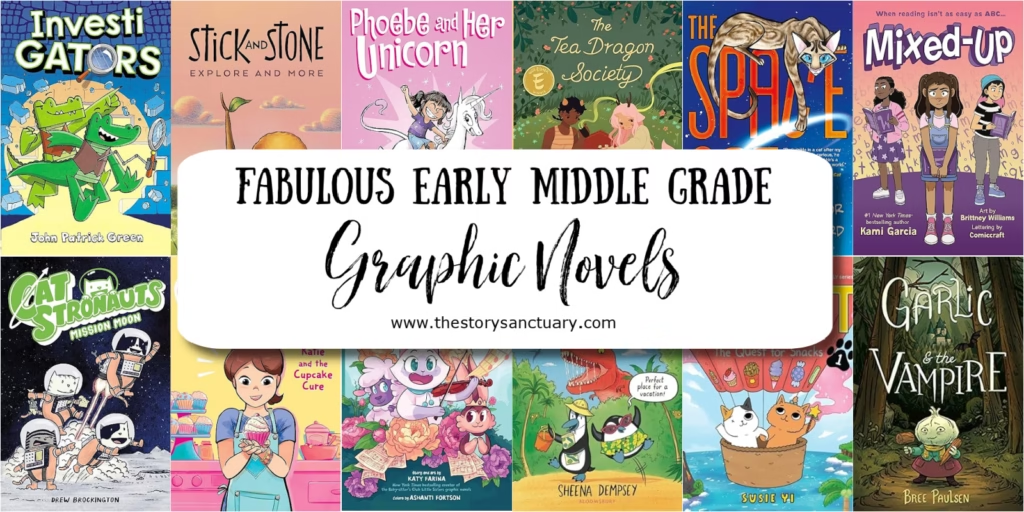
Fabulous Early Middle Grade Graphic Novels
My littlest is seven, and quite a reader. Keeping up with her reading keeps me on my toes. Lately, her favorite kinds of books to read are graphic novels. We’ve discovered some adorable chapter book-length graphic novels, but she blows through those in a blink. I wanted to try to find some longer graphic novels for her, which meant looking through middle grade titles to find some that are well-suited to her age. The age range for middle grade books is eight to twelve, so this means looking for books geared toward readers at the younger end of that age spread.
A few books in this list are standalone titles, but most of them are part of a series. For the series titles, I list the first book in the series, the total number of books available, and whether the series is ongoing.
It’s also worth noting that the Dog Man series is missing from this list. That’s really only because I haven’t been able to get my daughter excited about them and so haven’t read them myself. I’ve heard good things, though.
Note: This post contains affiliate links that do not cost you anything to use but help support this blog. Thanks for using them to do your shopping.
Fabulous Early Middle Grade Graphic Novels
Catstronauts by Drew Brockington
What you need to know: Cats. In. Spaaace! This silly series follows four cats tasked with various space missions to save the earth. Super cute. Contains some science references, but really the focus is on the cats and their roles in the missions.
Published April 18, 2017 | 7 Books | Ongoing Series
Pablo & Splash: Time-Traveling Penguins
Amazon | Bookshop | Goodreads | Full Review
What you need to know: Serious Pablo and Impulsive Splash accidentally enter a time machine and wind up on holiday with the dinosaurs. This series is lots of fun.
Published September 3, 2023 | 2 Books | Ongoing Series
Song of the Court by Katy Farina
What you need to know: This is one of my daughter’s favorites. It’s a sweet story about friendship with a work-life balance lesson thrown in there as well. The author has gone on to work on a Babysitters Club Graphic Novel series spin-off, so I suspect we’ll be adding those to the reading list.
Published October 6, 2020 | Standalone
Stick and Stone Explore and More by Beth Ferry and Kristen Cella
What you need to know: These might be a little closer to the chapter book graphic novel length. This two-book series is pretty gentle and nature-focused.
Published June 7, 2022 | 2 Books | Completed Series
Mixed-Up by Kami Garcia and Brittney Williams
Amazon | Bookshop | Goodreads | Full Review
What you need to know: This story centers a girl with dyslexia who’s reading struggle is starting to affect her friendships and school performance. Through the story, readers learn about tools and strategies available for kids with dyslexia. It’s an upbeat story with a positive message.
Published January 21, 2025 | Standalone
InvestiGators by John Patrick Green
What you need to know: InvestiGators Mango and Brash go undercover to stop crime and keep their city safe. Packed with pop culture jokes, references, and puns, this is a binge-worthy series. There’s also a spin-off series (Agents of S.U.I.T.) that features stories centering some of the minor characters in this one.
Published February 25, 2020 | 9 Books | Ongoing Series
The Tea Dragon Society by K. O’Neill
What you need to know: These books are some of O’Neill’s earlier work, but they contain the same cozy vibes and beautiful fantasy landscapes that they’re known for in later work. Also, the tea dragons are just adorable!
Published October 31, 2017 | 3 Books | Completed Series
The Space Cat by Nnedi Okorafor and Tana Ford
Amazon | Bookshop | Goodreads | Full Review
What you need to know: This graphic novel is told from a cat’s point-of-view. It’s a clever tribute to cats with a fun sci-fi twist.
Published August 12, 2025 | Standalone
Garlic and the Vampire by Bree Paulsen
Amazon | Bookshop | Goodreads | Full Review
What you need to know: A vampire moves into Garlic’s village, and her friends (also anthropomorphic vegetables) nominate her to find out about him. After all, she should be safe since garlic repels vampires! Sweet, anxious Garlic agrees to the task. This is a charming series, perfect for fall reading.
Published September 28, 2021 | 2 Books | Completed Series
Cupcake Diaries Graphic Novels: Katie and the Cupcake Cure by Coco Simon
What you need to know: This series is a graphic novel adaptation of the middle grade books by the same name. The illustrations are bright and cheery, and the pages filled with treats and stories about friendship.
Published September 13, 2022 | 8 Books | Ongoing Series
Phoebe and Her Unicorn by Dana Simpson
What you need to know: After rescuing unicorn Marigold Heavenly Nostrils, Phoebe makes a wish to be best friends, and that’s just what the two become. Think Calvin & Hobbs, but with a girl and her unicorn. The tone can be a little bit snarky, but overall, the messaging is positive.
Published September 7, 2014 | 22 Books | Ongoing Series
Cat & Cat Adventures by Susie Yi
What you need to know: These short volumes follow two cats who journey to a fantasy world and solve various problems there. It’s cute and easy to read. These are another favorite in our house.
Published September 7, 2021 | 5 Books | Ongoing Series
What Graphic Novels Should I Add to My List?
Help a girl out. What should my seven-year-old add to her reading list? Are there other graphic novels that she might like, based on this list? Leave a comment and let me know about them!